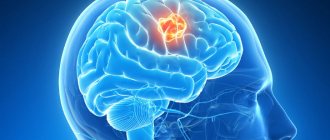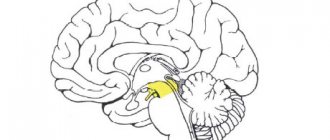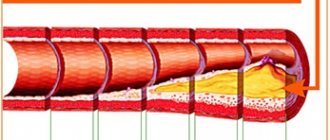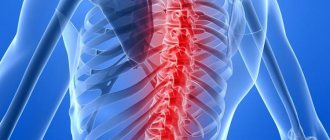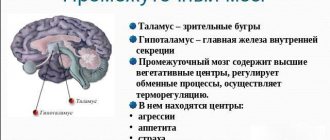Dizziness and vestibular disorders are related. The human vestibular apparatus is located in the inner part of the hearing organ. The human vestibular apparatus has receptors that are very sensitive and immediately detect any changes in body position. Vestibular vertigo creates a sensation of imaginary rotation of objects around the patient. Most often it is caused by certain damage to the vestibular apparatus; dizziness occurs as a result of damage to the central or peripheral parts of the vestibular analyzer. Other types of dizziness are associated with various diseases and are not related to damage to the vestibular system.
At the Yusupov Hospital they diagnose diseases that cause vestibular vertigo. In the hospital you can undergo examination, treatment and recovery in a rehabilitation clinic. The clinic carries out rehabilitation measures, uses therapeutic exercises, and various types of physiotherapeutic procedures. Instructors select exercises on simulators for patients suffering from dizziness. The vestibular apparatus, which is treated using various methods, is restored in 50-80% of patients after treatment and rehabilitation.
How to treat vestibular vertigo
Dizziness is a common complaint among patients about feeling unwell. Women and the elderly most often suffer from dizziness. Depending on the cause of dizziness, the doctor prescribes treatment. Treating dizziness is a difficult task for a doctor. He refers the patient for examination to determine whether dizziness is caused by diseases. The patient is prescribed symptomatic treatment, which helps to remove symptoms - nausea, vomiting, and stop attacks of dizziness. Vestibular suppressors are used to stop attacks. To prevent attacks from developing, your doctor may prescribe anticholinergic drugs. Such drugs are prescribed with caution to elderly people due to side effects - hallucinations, amnesia, they can cause urinary retention and psychosis in an elderly patient. Some types of antihistamines and benzodiazepines are also prescribed to enhance the inhibitory response of GABA to the patient’s vestibular system.
Treatment of diseases of the vestibular apparatus
Self-treatment for such symptoms is not recommended. This can lead to the development of chronic forms of the disease and complicate the diagnosis of the true causes of the pathology. Diseases of the vestibular system in children are much milder than in adults. But if any deviations in coordination, persistent nausea or dizziness occur, you should immediately consult a doctor. If you begin to notice regular malaise, problems with coordination of movements, or frequent bouts of dizziness, fill out the form on the screen.
Vestibular vertigo: symptoms and treatment in older people
Dizziness (vertigo) is manifested by the illusion of rapid rotation of objects around the patient. It may be accompanied by vomiting, nystagmus, nausea, and ringing in the ears. When vestibular vertigo develops in older people, the causes can be varied: lack of blood supply to the brain (cerebral ischemia), multiple sclerosis, head injuries, some types of brain tumors, tumors of the auditory nerve, hormonal imbalance, atherosclerosis, and other disorders. Treatment of vestibular vertigo (vertigo) in older people begins with finding the cause of the dizziness and treating the underlying disease. Vestibular gymnastics for dizziness in older people improves well-being, has a beneficial effect on the heart, musculoskeletal system, and nervous system. Treatment of vestibular vertigo is carried out with the help of drug therapy, physiotherapy, physical therapy, and reflexology.
What other folk recipes can you use?
The following recipes are also applicable as part of therapy:
- Using a healing drink from peony. Mix crushed peony rhizome and three tablespoons of linden inflorescences with the same amount of mint. Brew the raw material in one liter of water. Place the tightly closed pan in a warm place for one night. Drink 150 milliliters of filtered drink four times a day.
- Treatment of vestibular apparatus disorders using plantain. The dried crushed leaves of this plant are steamed in boiling water (200 milliliters). Infuse the composition for at least half an hour. Add a small amount of honey to the infusion and drink it before bed. The duration of such folk treatment of the vestibular apparatus is, as a rule, one and a half weeks.
- Treatment of disorders with seaweed. This plant is very effective for disorders of the vestibular apparatus. Grind the plant and take one spoonful of the drug twice a day.
The effect of traditional medicine will manifest itself if taken regularly.
Diseases of the vestibular system and dizziness
There are a number of diseases that lead to disorders of the vestibular apparatus:
- Vertebrobasilar syndrome.
- Meniere's syndrome.
- Vestibular neuronitis.
- Thrombosis of the auditory artery.
- Chronic bilateral vestibulopathy.
Vestibular vertigo can be caused by damage to the vestibular nucleus of the brain stem, the vestibular centers of the brain and vestibular connections may be affected. If the vestibular analyzer is affected, the patient will experience certain symptoms:
- Noise in ears.
- Hearing loss.
- Constant dizziness.
When the central parts of the vestibular apparatus (cerebellum, brain stem) are affected, benign paroxysmal positional vertigo, vestibular neuronitis or Meniere's disease are most often diagnosed.
The most common causes of vestibular syndrome.
Benign positional vertigo is considered the most common type of vestibular syndrome and vertigo syndrome.
Benign paroxysmal positional vertigo, or positional vertigo, is a brief, intense episode of dizziness that occurs due to a specific change in head position. In the presence of such PH, dizziness may occur when lifting the head up or turning the head. An episode of such dizziness can occur even when turning over in bed. It is believed that the cause of this type of dizziness is a violation in the structure of the semicircular receptors, which send unreliable information about the position of the head to the brain, which is the cause of the symptoms. The cause of benign paroxysmal positional vertigo (BPPV) can be head trauma, neuritis, and age-related changes. The disorders are believed to be associated with an abnormality in the interaction of the photocopy with the cupula within the membranous labyrinth, resulting from abnormal responses to endolymph movement during head movement.
Labyrinthine infarction results in sudden, significant loss of auditory and vestibular function and usually occurs in older patients. This condition sometimes occurs in younger patients with atherosclerotic vascular disease or the presence of hypercoagulable phenomena. Episodic dizziness can be a harbinger of complete occlusion and occur as a transient ischemic attack. After complete occlusion, the intensity of dizziness gradually decreases, but a certain instability during movement may persist for several months until vestibular compensation occurs.
Vestibular neuronitis . Nerve damage is associated with viral infections (herpes virus). The disease usually occurs in the autumn-spring period during the peak of acute respiratory infections. With vestibular neuronitis, episodes of dizziness occur without hearing loss and may be accompanied by nausea and vomiting. The duration of the episode can vary from several days to several weeks, with gradual regression of symptoms. Vestibular neuronitis may be accompanied by attacks of benign positional vertigo.
Labyrinthitis
Labyrinthitis is caused by an inflammatory process within the membranous labyrinth, which can be caused by a bacterial or viral infection. Labyrinthine viral infections cause symptoms of vertigo similar to vestibular neuritis, but in association with cochlear disturbances. Infections such as measles, rubella, and cytomegalovirus, as a rule, do not cause vestibular disorders. Bacterial labyrinthitis can be either with damage to the membranous labyrinth itself or in a serous form. The serous form of labyrinthitis is often observed in acute otitis media, when bacterial toxins diffusely enter the labyrinth.
Meniere's disease
Meniere's disease is a disorder of the inner ear and is characterized by episodic attacks of dizziness, sensorineural hearing loss, tinnitus, and a sensation of pressure on the ear membranes. First, hearing loss occurs at low frequencies, with gradual progression of hearing loss at other frequencies as episodes of the disease are repeated. Episodes of Meniere's disease?? characterized by true dizziness, usually with nausea and vomiting, and lasts for several hours. This disease is believed to be associated with expansion of the endolymphatic space, with ruptures and subsequent regeneration of the membranous labyrinth.
Migraine
Often, migraine attacks can be similar to attacks of Meniere's disease. But with migraine, hearing loss is less common than with dizziness, tinnitus, photophobia, and phonophobia. But, nevertheless, with migraine there may be a certain sensorineural hearing loss for low-frequency sound vibrations. Therefore, sometimes the differential diagnosis between these diseases is sometimes difficult. Multiple sclerosis also poses a diagnostic challenge in the differential diagnosis from migraine. In 5% of cases, multiple sclerosis may begin with debilitating dizziness, and in 50% of patients with multiple sclerosis, episodes of dizziness occur during certain periods of the disease. Moreover, one in ten patients with multiple sclerosis may have hearing loss, which can be partial or complete, which makes the symptoms similar to Meniere's disease or migraine.
Disembarkation disease Attacks of dizziness occur after disembarkation and the person continues to experience a swaying motion that persists after returning to a stable environment after prolonged exposure to motion (for example, after traveling on a train, car, or boat).
Other causes of vestibular syndrome . Damage to the vestibular analyzer can be caused by head trauma, whiplash injury, acoustic neuroma, drug intoxication following ear surgery, diseases of the musculoskeletal system (with impaired proprioception), diseases of the central nervous system.
Benign vestibular vertigo
Benign vestibular vertigo is most often considered a pathology of the inner ear; dizziness often occurs when turning the head to the side. The disease may manifest as sudden severe dizziness, nausea and vomiting. Paroxysmal benign positional vertigo develops as a result of the deposition of calcium salts in the ampulla of the semicircular canal. Peripheral vestibular vertigo occurs when the peripheral part of the vestibular apparatus is damaged. Systemic vestibular vertigo is manifested by symptoms of swaying one's own body, rotating objects, bending or falling, accompanied by impaired hearing, balance, nausea and vomiting. Caused by damage to the central or peripheral part of the vestibular system.
Remember the benefits of regular active training
Active rehabilitation ensures the entry into the central nervous system of all sensory stimuli that are normally involved in the regulation and implementation of basic vestibular functions, for example, ensuring the orientation of the body position in space and maintaining posture, fixing the position of the eyeballs and gaze, perceiving a vertical position and moving in space. A typical illustration of the above-mentioned theory of compensation for vestibular dysfunction is the role of visual perception in this process.
The process of visual sensory substitution, which normally occurs during the first few weeks after loss of vestibular function, requires the arrival of visual motor signals similar to those involved in the behavioral process. By comparing different groups of cats that underwent unilateral vestibular neurectomy and received static (strobe), passive (not related to their behavior) or dynamic (related to their movement in space) visual stimuli in the early period after damage to the vestibular apparatus, we demonstrated that postural- kinetic functions were markedly impaired in cases where visual motor stimuli were insufficient. Using this experimental animal model, we demonstrate for the first time a differential prevalence of visual stimuli at the level of the VUC, depending on the visual experience acquired after injury.
Vestibular cells located within the VUC and having descending projections to spinal motor neurons became more sensitive to rapid visual movement of surrounding objects over the first three weeks in cats receiving only dynamic visual stimuli (
).
demonstrates the response of vestibular neurons to optokinetic stimulation delivered at different frequencies. In unoperated cats of the control group, vestibular cells respond only to optikokinetic stimuli in the low-frequency range (up to 0.5 Hz). In cats, after unilateral vestibular neurectomy and exposure to passive or static visual stimuli after injury, the neuronal response remained unchanged. In contrast, in a group of animals exposed early to dynamic visual stimuli associated with their motor behavior, a response of vestibular neurons on the lesioned side was observed that increased their activated firing to 1 Hz. This supports the concept of visual stimulus dominance, a process of sensory substitution at the cellular level capable of detecting rapid changes in the visual environment based on visual cues (instead of missing vestibular information) (Y. Zennou-Azogui et al., 1994).
The data presented indicate that only the dynamic state of the body is capable of compensating for the absence of dynamic vestibular stimuli
. This increase in visually induced neuronal responses after vestibular damage was not observed in cats placed under a strobe light or in animals that received passive visual stimulation.
Overall, evidence from animal models clearly shows that optimal neuronal remodeling occurs only when active training programs are regularly implemented.
Exercises for vestibular vertigo
Dizziness often occurs when turning the head or body - this forces patients to try to avoid such movements. Gymnastics for patients with vestibular system disorders includes various types of exercises, including exercises with head and body turns. Exercises can be performed while sitting on a bed, with or without a pillow, sitting on a chair, or standing. The exercises are based on the principle of sensory mismatch between the movements of the eyes, torso and head. Special simulators that work on the principle of biofeedback will help increase the effectiveness of gymnastics. During the training period, you should avoid taking sedatives and alcohol.
Start rehabilitation as early as possible
In the work carried out on the experimental monkey model we created, we demonstrated for the first time that a decrease in the severity of postural and motor disorders in animals subjected to sensorimotor deprivation in the postoperative period occurred much later than in animals that were allowed to move freely. In fact, in these experiments on monkeys, we reproduced the behavior of a patient with Meniere's disease, who, after vestibular neurotomy, remains in bed for 1-2 weeks, deliberately creating a deficit in sensorimotor activity. Further experiments conducted in our feline experimental model also confirmed this clinically relevant observation.
Limiting the sensorimotor activity of the animal, avoiding a vertical position and movement significantly inhibited the process of restoration of vestibular functions. The onset of the vestibular compensation process depended entirely on the sensorimotor experience that the animal received immediately after damage to the vestibular apparatus; restoration of postural-kinetic functions could not occur in the absence of behavioral activity. In addition, by modeling sensorimotor deprivation of varying durations and its onset at different periods of time after damage to the vestibular apparatus, the process of restoration of vestibular functions, depending on the relationship of these two parameters, can either be prevented or slowed down to varying degrees (
).
We examined the effect of short-term sensorimotor restriction (SMR) on the profile of recovery of dynamic balance function after unilateral vestibular neurotomy in a cat. The SMR model was used to reproduce the behavior of a patient with Meniere's disease who was kept in bed for 1 week after such surgery. A 7-day SMR was simulated during the acute stage (days 0-7: SMR 1), the compensatory stage (days 14-21: SMR 2) and after full recovery (days 42-49) of the maximum degree of efficiency of the cat's motor functions during their study using a special rotating apparatus. It should be noted that the delay in the recovery profile is caused by a lack of early sensorimotor activity (SMR 1 and SMR 2) compared to a cat not subjected to activity restriction (SMR 3). Similar observations were made regarding the final degree of recovery, which, in the absence of early sensorimotor training, remains very low (40 and 50% for SMR 1 and SMR 2, respectively) (C. Xerri, M. Lacour, 1980).
We have proposed a model of vestibular compensation based on the concept, derived from developmental biology, that there must be a critical period for the reorganization of the central nervous system that occurs following brain damage. Data from a variety of molecular, biochemical, and behavioral studies support this important idea that, following acute loss of vestibular function, there is a specific sensitive period for exposure to afferent stimuli.
This period can be considered as a limited time window that favors the best neuronal reorganization and optimal recovery of impaired functions. It is limited to the early stage of the recovery process and corresponds to the first month of the postoperative period in patients with vestibular disorders. According to this concept, rehabilitation of patients with dysfunction of the vestibular apparatus should be carried out during this period, and, therefore, it is at this time that it is necessary to involve patients in the active implementation of intensive training programs, regardless of their age
.
Tablets for vestibular vertigo
Drugs for vestibular vertigo are Betaserc, Betagistin, Tagista, Vestibo, as well as drugs that support the endocrine system, the heart, and reduce blood pressure. Betaserc improves blood circulation in the brain and promotes the functioning of the vestibular apparatus. Betahistine is often used in complex treatment; it helps with nausea and vomiting. Tagista improves blood circulation in the brain and reduces lymph pressure in the labyrinth of the inner ear. A stable effect is achieved after a month of treatment. Vestibo improves blood circulation in the inner ear and brain; the drug is used in complex therapy.
Clinical manifestations of the disease
Disruption of the vestibular organ, as noted above, always leads to quite serious changes in the human body. Signs of vestibular disease may manifest as follows:
- causeless nausea for a long time; diseases of the vestibular apparatus make an appointment with a doctor
- vomiting, which does not bring relief and intensifies with changes in body position;
- impaired coordination and precision of movements;
- visual impairment;
- constant dizziness in any body position;
- increased sweating;
- change in skin color;
- arrhythmia and tachycardia;
- unstable blood pressure;
- shortness of breath and the appearance of pulmonary sputum.
Not all of the symptoms described above may appear together and necessarily indicate problems with the vestibular system. But you shouldn't ignore them. With irregular clinical manifestations, the patient, especially if it is a child, may be practically no different from healthy people.
Treatment in Moscow
The best treatment for vestibular disorders is considered to be exercises for dizziness or vestibular rehabilitation. Vestibular rehabilitation is carried out in many special centers, including the rehabilitation center of the Yusupov Hospital. Therapeutic gymnastics is carried out by an instructor, classes are developed individually for each patient. A preliminary examination by a neurologist will help determine the cause of dizziness, and the doctor will prescribe effective drug treatment. A neurologist will tell you what examination to undergo and how to cure vestibular vertigo during your consultation.
Additional factors and causes of violations
It is necessary to take into account that the operation of the device in question may be affected due to other diseases, among other things. In fact, there are quite a few of them, since this organ can react very receptively to many situations, especially to ear abnormalities and injuries. For example, otosclerosis, against the background of which pathological growth of the ear bones develops. In addition, the presence of wax plugs in the ear cavity can negatively affect a person. There may be other, rather rare factors in the malfunction of the device in question. Among them, tumors of the cerebellopontine angles occur along with syncopal migraine. The latter is often chronic, overtaking women in middle age. This is considered a type of migraine.
Serious dysfunction of the vestibular apparatus can be caused by epilepsy. With this pathology, patients experience partial loss of consciousness during attacks. One of the main factors for identifying the disease is hallucinations. Among other things, platybasia may occur along with a congenital malformation. This factor in the occurrence of disorders is combined with dizziness and damage to the cerebellar system. When disturbances in the operation of this apparatus are accompanied by rotational dizziness with vomiting, it is worth paying attention, as this may become one of the signs of multiple sclerosis (pathology of the nervous system).
Treatment of vestibular neuritis
Treatment of the disease is carried out in the following areas:
- If neuritis occurs against the background of a viral infection, antiviral drugs may be prescribed.
- Medicines that help cope with the main symptoms of the pathology - dizziness, nausea, vomiting.
- Drugs that improve microcirculation and metabolic processes in nervous tissue, increasing resistance to oxygen starvation.
After the symptoms subside, special gymnastics are prescribed for the eyes, head, and whole body. First, all exercises are performed in a lying position, then the patient moves to a sitting or standing position.
Vestibular neuritis is a disease that is not particularly dangerous. But this is not a reason to self-medicate. Visit a neurologist. You can make an appointment with a specialist doctor at the Medica24 international clinic at any time of the day by calling +7 (495) 230-00-01.
Get a doctor's consultation by phone
Message sent!
expect a call, we will contact you shortly
With vestibular neuritis, inflammation of the vestibulocochlear (vestibular-cochlear) nerve develops; the brain cannot fully evaluate information about the position of the head and body in space, and about movements. As a result, characteristic symptoms of the disease arise.
GBOU "NIKIO im. L.I. Sverzhevsky" of the Moscow Department of Health
Developer institution:
State budgetary healthcare institution "Scientific and Practical Center of Otorhinolaryngology" of the Moscow Department of Health and the Department of Otorhinolaryngology of the Medical Faculty of the State Educational Institution of Higher Professional Education "Russian State Medical University".
Compiled by:
Doctor of Medical Sciences prof. A.I. Kryukov ; Doctor of Medical Sciences, Prof. V.T.Palchun ; Doctor of Medical Sciences prof. N.L. Kunelskaya ; Doctor of Medical Sciences M.V. Tardov ; Ph.D. HER. Zagorskaya; Ph.D. E.S.Yanyushkina, Ph.D. E.V. Baibakova; Ph.D. M.A. Chugunova; Ph.D. Yu.V. Levin ; Ph.D. A.L. Guseva; Z.O.Zaoeva.
Reviewers:
Doctor of Medical Sciences, Professor I.D. Stulindoctor of Medical Sciences, Professor S.V. Morozova
Purpose:
The methodological recommendations describe a diagnostic algorithm for central dysfunction of the vestibular analyzer, a pathology manifested by dizziness - one of the most common complaints during outpatient visits. The methodological recommendations are intended for otorhinolaryngologists, neurologists, otoneurologists and general practitioners.
This document is the property of the Moscow Department of Health and may not be reproduced without appropriate permission.
Introduction
When examining a patient with complaints of dizziness, it is first necessary to differentiate between peripheral and central vestibular syndromes.
The role of nystagmus in topical diagnosis is limited, but some of its types may correspond to certain local brain damage. It should also be noted that there is no nosological specificity of various types of nystagmus.
It is generally accepted that horizontal nystagmus most often corresponds to damage to the peripheral part of the vestibular analyzer. A pronounced rotatory component of nystagmus indicates involvement of central structures in the process.
Vertical nystagmus with a downward fast phase direction may correspond to damage to the cervicomedullary region and inferior cerebellar peduncles, and with an upward fast phase direction it can be recorded with damage to the anterior parts of the vermis or superior cerebellar peduncles (Arnold-Chiari malformation type I). Also associated with pathological processes in the area of the craniovertebral junction is periodic alternating nystagmus - a cyclic disorder in which horizontal jerky nystagmus spontaneously acquires the opposite direction with a periodicity of 1 to 3 minutes.
Retraction nystagmus, characterized by irregular twitching of the eyes into the orbit, is associated with lesions of the midbrain tegmentum or quadrigeminal. This type of nystagmus can be combined with pulsating, as well as convergent nystagmus, which is characterized by slow divergent movements of the eyeballs, interrupted by fast convergent impulses.
Lesions of the caudal parts of the pons sometimes cause floating movements of the eyeballs - rapid downward movements of the eyeballs followed by a return to their original position. Nystagmoid twitching of one eye occurs with severe damage to the midbrain and lower parts of the pons.
Sawtooth nystagmus develops with lesions of the caudal parts of the brain stem and consists of rapid unfriendly eye movements, in which one eyeball turns upward and inward, and the other downward and outward.
A rare, unusual movement disorder of the eyeballs, called opsoclonus, consists of a bout of sequential saccades that are associated with damage to the cerebellum, and less commonly, the brainstem or thalamus. In cases where such saccades occur in the horizontal plane, the terms “ocular myoclonus” or “dancing eyes syndrome” are used.
If a peripheral syndrome is diagnosed, it may be necessary, in addition to audiological and vestibulological studies, to conduct: multislice computed tomography (MSCT) of the temporal bone to assess the pathology of the labyrinth; magnetic resonance imaging (MRI) to verify the formation of the cerebellopontine angle and vaso-neural conflict.
If a violation of the functions of balance and coordination of the central type is diagnosed, then a neurological examination should determine the areas of damage: the vestibular nuclei of the brainstem, the upper brainstem structures, the cerebellum and its pathways, the frontal or parietal cortex. Confirmation of the topical diagnosis is provided by MRI of the brain, and to clarify the etiological factors, radiography of the cervical spine and cranio-vertebral junction, as well as ultrasound examination of blood flow in the main arteries of the neck and head are used.
Anatomy and physiology of the vertebrobasilar system
The paired vertebral artery (VA), arising from both sides of the subclavian artery, is its first and largest branch (Fig. 1). According to A.V. Pokrovsky, the following segments of PA are distinguished:
Figure 1. Trajectory of the vertebral artery.
1) The first segment (V1) from the mouth to the entry into the canal of the transverse processes of the cervical vertebrae. As a rule, the artery enters the transverse process of the sixth or fifth cervical vertebra.
2) The second segment (V2) – before the exit from the foramen of the transverse process of the second cervical vertebra. In the absence of vertebral pathology, the course of the vessel in this segment is relatively straightforward: each vertebral artery is held almost exactly in the center of the opening of the transverse process with the help of thin connective tissue trabeculae and remains intact during any movement in the cervical joints within the limits of physiological mobility.
3) The third segment (V3) – before entering the cranial cavity. After leaving the opening of the transverse process of the axis, the vertebral artery deviates outward and enters the opening of the transverse process of the atlas. Further in the horizontal plane, heading dorsally, it bends around the lateral mass of the atlas, turns up and forward and, piercing the atlanto-occipital membrane, penetrates into the cranial cavity through the foramen magnum. In this segment, the artery makes four bends in different planes, including two at right angles, which, in accordance with the laws of hydrodynamics and similar to the siphon of the internal carotid artery, ensures smoothing of the pulse wave and uniformity of blood flow.
4) The fourth segment (V4) - to the confluence of the right and left vertebral arteries on the lower surface of the medulla oblongata or the bridge into the basilar artery (BA).
At the level of the first cervical vertebra, the VA is surrounded by the atlanto-occipital sinus, in which it is “suspended” by fibrous cords. The walls of the sinus are unyielding; As a result, the pulsation of the artery in the sinus cavity stimulates the outflow of venous blood, being an important regulatory mechanism of cerebral hemocirculation.
The radicular arteries depart extracranially from the VA, supplying the lower cervical (C4-C8) and upper thoracic (Th1-Th3) segments. The four upper cervical segments (C1-C4) are supplied by the anterior spinal artery, which is formed by the fusion of the anterior spinal arteries, branches of the vertebral arteries. The PA and anterior spinal arteries on the anterior surface of the medulla oblongata form an anastomotic rhombus.
Intracranially, the vertebral and basilar arteries give off small branches that supply blood to the medulla oblongata and the pons, respectively.
The largest branch of the VA is the posterior inferior cerebellar artery, which provides vascularization to the inferior surface of the cerebellum. It also gives branches to the villous plexus of the fourth ventricle, the ventrolateral surface of the medulla oblongata, and to the roots of the X, IX, VIII and VII cranial nerves. The same artery is the source of the posterior spinal artery.
From the caudal segment of the basilar artery arises the anterior inferior cerebellar artery, which supplies the inner ear (Fig. 2), part of the inferior peduncles and the ventral part of the cerebellum.
| 1 – main artery; 2 – anterior inferior cerebellar artery; 3 – anterior vestibular artery; 4 – artery of the labyrinth; 5 – common cochlear artery; 6 – main cochlear artery; 7 – posterior vestibular artery |
Figure 2. Blood supply to the inner ear.
The oral portion of the basilar artery gives rise to the superior cerebellar artery, which carries blood to the convexital surface of the cerebellar hemispheres.
The main artery in its normal development is divided into the right and left posterior cerebral arteries, the branching area of which extends to the lower surface of the temporal and occipital lobes to the parieto-occipital sulcus. The area of the artery's blood supply includes the hypothalamus, cerebral peduncles, posterior parts of the corpus callosum, hippocampus, ependyma of the lateral ventricles, choroid plexuses and, most importantly, the visual cortex.
Intravasal factors influencing
on the vertebrobasilar blood flow
In addition to regulatory factors, the features of cerebral vascular architecture have a huge impact on blood flow in the vertebrobasilar system. Analysis of the structure of the arterial system of the brain showed that its typical structure (Fig. 3) occurs in no more than 50% of cases. It is important to emphasize that the variability in the development of the arteries of the posterior basin significantly exceeds the variety in the structure of the branches of the carotid system: thus, posterior trifurcation is recorded with a frequency of up to 25% of cases, and variants of the structure without fusion of the vertebral arteries are also found. The diameters of the vertebral arteries are often different - in 25-30% of cases the right vertebral artery predominates, and the left one can predominate with the same frequency.
| 1 – intracranial part of the internal carotid artery; 2 – middle cerebral artery; 3 – anterior cerebral artery; 4 – anterior communicating artery; 5 – posterior communicating artery; 6 – posterior cerebral artery; 7 – main artery; 8 – superior cerebellar artery; 9 – anterior inferior cerebellar artery; 10 – posterior inferior cerebellar artery; 11 – vertebral artery. |
Figure 3. Structure of the large arterial circle of the brain.
The variant of the origin of the vertebral artery from the subclavian artery is important. There are frequent cases where the mouth of the vertebral artery is located not on the upper, but on the posterior and even lower wall of the subclavian artery, which leads to deformation of the initial segment of the VA with a high probability of the formation of a local hemodynamic difference, limiting the blood flow in the vessel.
Separately, mention should be made of such important intracranial anastomoses as the posterior communicating arteries: the absence of one posterior communicating artery is recorded in 6-10% of cases, and the absence of both posterior communicating arteries is not uncommon - complete separation of the posterior sections of the circle of Willis.
Intravascular factors affecting the vascularization of the brain include various types of stenotic processes in the vertebral and basilar arteries: atherosclerotic, inflammatory, fibromuscular hyperplasia.
Extravasal effects on vertebrobasilar blood flow
Persistent or transient compression of the vertebral artery in the canal of the transverse processes or, less frequently, in the intermuscular spaces can cause a decrease in blood supply to the vertebrobasilar region, as well as a narrowing of the lumen of the artery due to a plaque or thrombus. The clinical picture of suffering develops depending on the development of collaterals and the structure of the arterial circle at the base of the brain. In the latest version of the International Classification of Diseases, 10th revision, such a symptom complex is defined as “vertebrobasilar arterial system syndrome” within the framework of “transient transient cerebral ischemic attacks (attacks) and related syndromes” (G 45.0).
According to the areas of vascularization of the vertebral basin and the basilar artery, the symptoms associated with impaired blood flow in the VBS are diverse and include cochleovestibular disorders, visual and oculomotor disorders; violations of statics and coordination of movements. It is this symptom complex that occurs in more than 80% of patients with circulatory failure in the posterior circulatory system.
Visual and oculomotor disorders are very common phenomena and are manifested by blurred visual fields, blurred vision of objects, photopsia or scintillating scotomas and loss of visual fields. Oculomotor disorders are expressed by transient diplopia (in different directions of gaze) with mild paresis of the eye muscles and convergence insufficiency.
Static and dynamic ataxia is one of the most common symptoms, manifested by complaints of instability and staggering when walking. Coordination of movements may also be affected.
Cochleovestibular disorders manifest themselves in the form of acutely developing systemic or non-systemic dizziness, sometimes with spontaneous nystagmus, dizziness is often accompanied by nausea and vomiting. There is tinnitus of various timbres: from high (squeaking and whistling) to low tones (surf noise, buzzing). In this case, dizziness as a monosymptom can be regarded as a reliable sign of dyscirculation in the VBS only in combination with other signs of circulatory disorders in it in patients with a relatively persistent otoneurological symptom complex.
Less known, although not uncommon, are optic-vestibular disorders. These include symptoms of “wavering shadow” and “convergent vertigo,” when sufferers experience dizziness or unsteadiness when seeing flashes of light and shadow or when looking down. Various types of visual agnosia with impaired optical-spatial perception can be identified, as well as elements of sensory and amnestic aphasia as a result of ischemia in the distal cortical branches of the posterior cerebral artery.
Characteristic symptoms are attacks of sudden falling and immobility without loss of consciousness (drop attacks) and with loss of consciousness (Unterharnsteidt's syndrome), usually occurring with sudden turns or throwing back the head. Manifestations of diencephalic disorders include severe general weakness, irresistible drowsiness, disturbances in the rhythm of sleep and wakefulness, as well as various autonomic-visceral disorders, sudden increases in blood pressure, heart rhythm disturbances, etc.
The basis for the expanded diagnosis of the syndrome of transient circulatory disorders in VBS may be the unjustified inclusion of symptoms related to the initial stages of the well-studied “vertebrogenic vertebral artery syndrome”. Its initial or angiodystonic stage is defined as a syndrome of vertebrogenically caused irritation of the perivascular sympathetic plexus of the vertebral artery with typical pain (vegetalgic) symptoms. These peculiar cervico-occipital pains, spreading to the parietal, temporal regions and orbit, are often described as “removing the helmet.” The predominant pain component is felt as a burning sensation, paresthesia, a feeling of squeezing or fullness in the eyes, ears, and throat. The described phenomena intensify with a sharp change in the tilt of the head or in an uncomfortable position, especially after sleep. Visual and cochleovestibular symptoms are also peculiar and usually arise or worsen not as isolated symptoms, but during attacks of characteristic headache.
Features of the course of the vertebral artery in the intermuscular spaces and in the canal of the transverse processes determine the options for possible extravasal influences on it. The effect of muscles on PA is associated with their segmental tonic tension, usually as part of myofascial syndromes associated with osteochondrosis of the cervical spine.
Before entering the canal of the transverse processes, the vertebral artery may be compressed by the edge of the anterior scalene muscle or the longus colli muscle. A more common option is compression of the VA before entering the cranial cavity by the inferior oblique muscle of the head, which, with a sharp turn and tilt of the head, stretches and can impinge on the greater occipital nerve, branches of the second cervical nerve and the VA itself.
More complex and ambiguous effects on the VA can be exerted by the structures that make up the canal of the transverse processes. Arthrosis of the uncovertebral joints can lead to direct compression with changes in the course of the entire intraosseous segment of the vertebral artery. With ultrasound angioscanning or radiopaque imaging methods, the artery takes on a “tortuous” appearance, bending around the deformed joints.
Excessive mobility (instability) of the motor segments of the cervical spine creates conditions for mechanical effects on the VA: compression of the artery or irritation of the periarterial sympathetic plexus.
Complex effect on the vestibular analyzer
As a rule, individual manifestations of abnormalities of the cervical spine or the vascular system of the brain are not so significant as to cause dizziness or impair coordination. The clinical situation may vary due to a combination of several abnormal and pathological factors.
For example, a combination of hypoplasia of one of the vertebral arteries and incompetence of the contralateral posterior communicating artery (Fig. 4) may not lead to coordination disorders. However, in the case of the development of instability or muscular-tonic phenomena against the background of a violation of the statics of the cervical spine - phenomena that can cause a mechanical effect on the hemodynamically predominant VA - cerebral syndrome may debut with dizziness.
| 1 – right posterior communicating artery; 2 – absence of the left posterior communicating artery; 3 – hypoplastic right vertebral artery; 4 – hemodynamically predominant vertebral artery |
Figure 4. Combination of vertebral artery hypoplasia and contralateral posterior communicating artery incompetence.
A similar situation may arise if the patient has an Arnold-Chiari malformation. This pathology may not manifest itself clinically until a violation of the motor stereotype of the cervical spine is formed or arterial hypertension develops, accompanied by microcirculatory disorders, especially at the level of the venous segment. These processes can ultimately lead to compression of the VA or the cerebellar tonsils themselves, and to liquorodynamic disorders.
Thus, identifying positional (vertebrogenic) nystagmus requires expanded examination: ultrasound examination of blood flow in the VBS and radiation examination of the cervical spine.
Radiation diagnostics of spinal pathology.
Survey radiographs of the spine, in accordance with the recommendations, are necessarily performed in two projections, which makes it possible to study the structure of the vertebral body, the height of the intervertebral spaces, and the condition of the intervertebral and hamate joints. Spot-on images of the atlantoaxial joint demonstrate the features of Cruvelier's joint. If an anomaly of the craniovertebral joint is suspected, a special imaging technique is used to calculate the angles between the components of the skull base and the axis of the odontoid process.
A large group of radiological symptoms of osteochondrosis is associated with impaired static function of the spine. On radiographs, this is manifested by a change in the axis of the spine - straightening of the cervical and lumbar lordosis or increased thoracic kyphosis. When the C5-C7 discs are affected, complete straightening of the cervical lordosis is usually determined; changes in the C3-C5 discs cause only partial straightening of the lordosis. Kyphosis may form. In this case, the distance between the processes at the level of kyphosis increases.
| Figure 5. Spondylolisthesis. |
Objective data on the mobility of the cervical spine are provided by functional x-ray studies with flexion and extension, accompanied by the effect of strengthening or weakening hidden displacements of the vertebrae. Radiographs with functional tests may reveal displacement of the vertebrae (Fig. 5) forward and backward. The simultaneous displacement of two or more vertebrae in the same direction is referred to as scalene displacement. These changes indicate a loss of the fixation ability of the disc and the initial manifestations of osteochondrosis.
Instability of motion segments in the cervical spine is common, which is often associated with posterior extensor subluxation according to Kovacs. A characteristic feature of subluxation according to Kovacs is the presence of displacement of the lower edge of the articular process during extension, which is normalized in a neutral position or during flexion. Such a subluxation appears during extension and indicates pathological mobility of the spinal motion segment (SMS) and the possibility of a direct vertebrogenic effect on the VA. Another symptom of pathological mobility is the bevel of the anterior-superior angle of the vertebra in the lateral projection.
The indicator of instability of the SDS is determined for all segments of the cervical spine. Particularly clinically significant is pendulum-shaped polysegmental instability at the mid-cervical level (the level of passage of the VA in the canals of the transverse processes) with a high degree of instability - the instability index is above 3 mm.
The most important from a clinical point of view and studied in detail in relation to X-ray diagnostics are the following forms of degenerative-dystrophic lesions of the spine: osteochondrosis, spondylosis deformans, fixing ligamentosis (Forestier disease), disc herniation (posterior cartilaginous node), Schmorl's hernia, spondyloarthrosis.
It is important to identify, using radiography, anomalies of the craniovertebral junction - congenital or acquired disorders of the structure of the base of the skull or the upper cervical spine. The abnormal structure of bone structures leads to a narrowing of the bone spaces containing the lower parts of the brain stem and the cervical spinal cord, which can lead to hemo- and liquorodynamic disorders, as well as compression of the brain elements themselves, manifested by cerebellar, vestibular and spinal disorders. A clinical picture of damage to the caudal group of cranial nerves may also be observed. The most common are:
- assimilation of the atlas (fusion of the first cervical vertebra with the skull) in the area of the foramen magnum;
- platybasia – flattening of the base of the skull;
- basilar impression – displacement of the odontoid process upward into the area of the foramen magnum;
- Klippel-Feil anomaly – fusion of cervical vertebrae;
- atlantoaxial dislocation – displacement of the atlas anteriorly in relation to the axis (second cervical vertebra), often observed in the absence or underdevelopment of a tooth, its non-fusion with the vertebral body;
- Kimerli's anomaly - the presence of an additional bone arch-semi-ring, forming a bone canal instead of the groove of the vertebral artery above the arch of the first cervical vertebra (Fig. 6);
| Figure 6. Kimerli anomaly. 1 – vertebral artery, 2 – bone bridge |
– Arnold-Chiari malformation type I – descent of the cerebellar tonsils into the foramen magnum (Fig. 7).
| Figure 7 . Arnold-Chiari malformation. 1 – cerebellum; 2 – cerebellar amygdala; 3 – atlas; 4 – spinal cord. |
If there are clinical signs of pathology of the cervical roots (shooting pain, loss of tendon reflexes, sensitivity zones), an MSCT or MRI of the cervical spine is necessary. It is these techniques that make it possible to reliably diagnose Arnold-Chiari malformation.
Tomography data is used to determine the presence of protrusions and herniations of intervertebral discs and their effect on the posterior longitudinal ligament and spinal nerve roots. Compression of the spinal cord or anterior spinal artery causes not only segmental sensitivity and movement disorders, but also conduction sensitivity disorders, and in severe cases, pyramidal insufficiency and dysfunction of the pelvic organs, which corresponds to the concept of cervical level myelopathy.
Ultrasound examination of cerebral blood flow.
The primary assessment of the condition of the neck arteries is carried out using a linear sensor of an ultrasound scanner: after excluding developmental anomalies of the brachiocephalic arteries, the parameters of flow velocity and resistance are recorded. Then a Doppler study of blood flow in the cerebral arteries is performed using transtemporal and suboccipital access using standard methods. The middle (MCA), anterior (ACA), posterior (PCA), vertebral (VA) arteries on both sides and the basilar artery (BA) are located. Using compression tests, the functions of the connecting arteries are assessed. Next, blood flow rates in the cerebral venous trunks are assessed: veins of Rosenthal, Galen, middle cerebral veins; straight and cavernous sinuses.
When assessing the LSC in the located arteries, the symmetry (equality) of the LSC in paired vessels is taken into account, as well as the compliance of the LSC with age standards and the observance of the proportions between the LSC in the extra- and intracranial arteries.
The next step is to study the PA in the third segment after repeating the head rotation three times at the maximum angle from side to side (pendulum test - MP). In this case, a Dopplerogram is recorded corresponding to the third cardiac cycle in a standard position after completion of movements. Turning the head in a flexion position makes it possible to evaluate the effect on PA at the upper cervical level, in a neutral position - in the interscalene space, and tilting the head back and forth - at the mid-cervical level. Before Doppler tests, blood pressure is measured with an electronic tonometer.
Ultrasound angioscanning plays an important role in studying the trajectory and intraluminal contents of arterial arteries, which makes it possible to detect stenosis of the lumen (atherosclerotic plaque, thrombus, fibromuscular dysplasia), pathological tortuosity, and dissection of the arterial wall. Identification of the local hemodynamic difference in flow velocity in the artery is of fundamental importance.
Predisposing factors for dissection include neck injuries and infections, however, apparently, local disruption of the properties of the vessel wall is also important in the development of this pathology. When clarifying the circumstances of the occurrence of dizziness, information may be important not only about the effects on the cervical-occipital region (pulsation techniques of manual therapy), but also about the patient’s long stay in a position with a fixed neck, as in dental or ophthalmological treatments.
Dopplerographic dissection of the wall of the cervical artery is manifested by a pattern of stenotic blood flow in the area of interest, which is caused by a narrowing of the lumen of the artery at the level of pathology: an increase in BFV, an expansion of the spectrum due to high frequencies, a difference in peripheral resistance parameters between the pre- and poststenotic segments. Sometimes a “double” spectrum can be insonated due to the superposition of the sound of the flow in the main channel and in the hematoma channel. With angioscanning in the dissection area, it is possible to visualize thickening of the arterial wall with a wide anechoic layer and narrowing of the arterial lumen in the absence of intraluminal formations. If the course of the process is unfavorable, thrombosis may develop in the narrowing zone.
Angioscanning also allows you to evaluate the diameter and shape of the lumen of the internal jugular veins, the speed of blood flow in the jugular and vertebral veins. Exceeding standard values may indicate difficulty in venous outflow from the cranial cavity, which often correlates with the presence of labyrinthine hydrops.
Neuroimaging techniques
MRI or MSCT of the head is indicated for the patient when a central type of lesion of the vestibular analyzer is detected. MRI in standard magnetic sequences (T1, T2, FLAER) allows you to identify infarct and post-hemorrhagic lesions in the brain, signs of leukoaraiosis and hydrocephalus, space-occupying formations, incl. neoplasms of the cerebellopontine angle.
Magnetic resonance angiography (MRA) in the first (arterial) phase allows to identify abnormalities in the structure of the arteries (aneurysms, arteriovenous malformations), as well as significant stenoses of the intracranial arteries. In the second (venous) phase, anomalies in the structure of the veins and sinuses of the dura mater can be assessed.
MSCT of brain vessels is a study that is more sensitive than MRA and is carried out with a bolus injection of intravenous contrast. This technique also allows you to evaluate separately the arteries and veins of the brain.
In some cases, three-dimensional reconstruction of the arterial and venous beds, which is possible with modern tomographic devices, brings great diagnostic benefit.
To identify the neurovascular conflict of the VIII cranial nerve and the arteries of the SMV, special MRI programs (usually on high-tensile installations - 3T) 3D-SPGR and 3D-FIESTA are used.
List of abbreviations
- PCA – posterior cerebral artery
- MP – pendulum test
- MRA – magnetic resonance angiography;
- MRI – magnetic resonance imaging
- MSCT – multislice computed tomography
- OA – main artery
- VA – vertebral artery
- SMS – vertebral motion segment
- ACA – anterior cerebral artery
- MCA – middle cerebral artery
